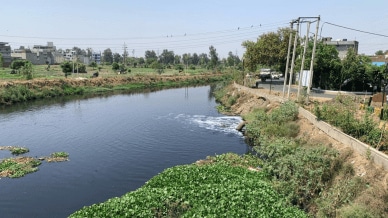Stay updated with the latest - Click here to follow us on Instagram
Buddha Nullah woes: NGT raps dyeing industry for ‘years of negligence’, directs MoEF&CC & PPCB to submit report on violations by CETPs
This stems from the NGT's concern over the long-standing issue of inadequate pollution control measures by the industry's common effluent treatment plants (CETPs).

The National Green Tribunal (NGT), in its latest order, has criticised the dyeing industry in Ludhiana for “years of unchecked pollution and institutional failure”. This stems from the NGT’s concern over the long-standing issue of inadequate pollution control measures by the industry’s common effluent treatment plants (CETPs).
The NGT, in its order, has set a two-month deadline for the Ministry of Environment, Forest and Climate Change (MoEF&CC) to complete its ongoing proceedings into the matter, and directed the Punjab Pollution Control Board (PPCB) to submit a comprehensive report on violations by the CETPs, along with environmental compensation calculations and recovery. All parties are to file compliance affidavits at least a week before the next hearing, scheduled for October 7.
monthly limit of free stories.
with an Express account.
Acting on multiple petitions filed by the Public Action Committee (PAC), the NGT documented “extraordinary levels of non-compliance with environmental clearance conditions”, most notably the illegal and continued discharge of effluents directly into the city’s highly polluted stream, Buddha Nullah — earlier known as Buddha Dariya — in “blatant violation of binding environmental safeguards”. It has also issued notices to the authorities concerned to fix this issue at the earliest.
In the petitions, the dyeing industry in Ludhiana has been accused of polluting the Buddha Nullah — already carrying domestic and industrial waste — with its toxic discharge, as the nullah water further mixes into Sutlej River, whose water is used for drinking purposes.
The industry’s three CETPs with the capacity of 15 MLD, 40 MLD, and 50 MLD were found to be in gross and prolonged violation of their environmental clearance mandates — flouting the zero liquid discharge (ZLD) condition, absence of consent to operate, as well as unauthorised and direct discharge of wastewater into Buddha Nullah since their inception.
In its compliance report, the MoEF&CC had also confirmed that the 15-MLD CETP, run by Bahadur Ke Textiles & Knitwears Association, is “continuously discharging 15 MLD treated water to Buddha Nullah”. The 40-MLD and 50-MLD CETPs, run by Punjab Dyers Association, are “continuously dispatching 40 MLD and 50 MLD treated waste water, respectively, to the Buddha Nullah”.
According to the NGT order dated July 22, a copy of which was uploaded on Tuesday, it has been informed by the authorities concerned that the environmental compensation, totaling over Rs 10 crore, has already been imposed on the CETPs — Rs 4.5 crore on the 15-MLD unit, Rs 2.96 crore (40-MLD unit), and Rs 2.49 crore (50-MLD unit). “Despite these penalties and other revoked permissions, the CETPs continue to operate and pollute,” the NGT noted.
On the core violation of the ongoing discharge of treated effluent into Buddha Nullah, the NGT said it is in “clear defiance” of specific conditions, under which these CETPs were granted environmental clearance. Asserting the CETPs have “entirely failed” to implement zero liquid discharge (ZLD), it noted: “There is no system to recycle effluent, no return pipeline to industries, and no destruction mechanism via reverse osmosis or evaporators — as was mandated.”
The NGT, citing the MoEF&CC audit, further noted “a pattern of total regulatory failure” including no online monitoring of effluent; no MoUs between CETPs and member industries regulating flow and quality; effluent transported without CETP tankers, manifest system or GPS tracking; hazardous waste generated but no authorisation obtained; no functional environmental management cells or green belt development; and no compliance reporting to MoEF&CC or Punjab Pollution Control Board (PPCB). It emphasised that “the failures exist since the inception of CETPs”, resulting in prosecution under the Water (Prevention and Control of Pollution) Act, 1974.
While a high-level committee has been formed by the Punjab government, to address pollution in Buddha Nullah, the NGT flagged serious gaps, noting the PPCB and the state Environment Department were excluded — despite being legally accountable. It also objected to the unexplained inclusion of NGT in the committee’s mandate, urging a “clearer and more effective oversight framework”.
The NGT action follows three ‘original applications’ and as many ‘execution applications’ filed by PAC Mattewara — a coalition of local residents and environmental advocates. The tribunal recognised the presence and grievances of affected citizens during hearings, and recorded their complaints against continued pollution. It further directed the MoEF&CC to consider hearing citizen representatives as part of its ongoing enforcement drive.
“This order marks a watershed moment in the long-running struggle for environmental justice in Ludhiana. It confirms years of administrative failure, industrial disregard for law, and the pivotal role of citizen-led action in bringing accountability,” PAC member Kapil Arora, also a petitioner, said.